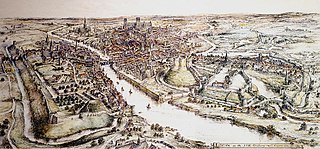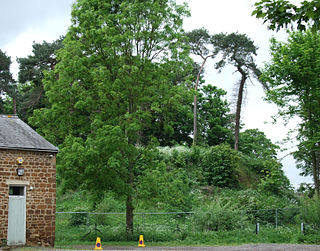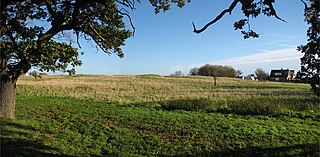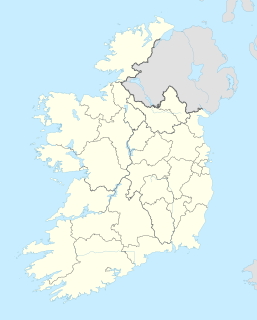
A castle is a type of fortified structure built during the Middle Ages predominantly by the nobility or royalty and by military orders. Scholars debate the scope of the word castle, but usually consider it to be the private fortified residence of a lord or noble. This is distinct from a palace, which is not fortified; from a fortress, which was not always a residence for royalty or nobility; and from a fortified settlement, which was a public defence – though there are many similarities among these types of construction. Usage of the term has varied over time and has been applied to structures as diverse as hill forts and country houses. Over the approximately 900 years that castles were built, they took on a great many forms with many different features, although some, such as curtain walls, arrowslits, and portcullises, were commonplace.

A motte-and-bailey castle is a fortification with a wooden or stone keep situated on a raised area of ground called a motte, accompanied by a walled courtyard, or bailey, surrounded by a protective ditch and palisade. Relatively easy to build with unskilled labour, but still militarily formidable, these castles were built across northern Europe from the 10th century onwards, spreading from Normandy and Anjou in France, into the Holy Roman Empire in the 11th century. The Normans introduced the design into England and Wales following their invasion in 1066. Motte-and-bailey castles were adopted in Scotland, Ireland, the Low Countries and Denmark in the 12th and 13th centuries. Windsor Castle, in England, is an example of a motte-and-bailey castle. By the end of the 13th century, the design was largely superseded by alternative forms of fortification, but the earthworks remain a prominent feature in many countries.

The Castle, Newcastle, or Newcastle Castle is a medieval fortification in Newcastle upon Tyne, England, built on the site of the fortress that gave the City of Newcastle its name. The most prominent remaining structures on the site are the Castle Keep, the castle's main fortified stone tower, and the Black Gate, its fortified gatehouse.

Sandal Castle is a ruined medieval castle in Sandal Magna, a suburb of the city of Wakefield in West Yorkshire, England, overlooking the River Calder. It was the site of royal intrigue and the setting for a scene in one of William Shakespeare's plays.

Callan is a market town in County Kilkenny in Ireland. Situated 16 km (10 mi) south of Kilkenny on the N76 road to Clonmel, it is near the border between County Tipperary. It is the second largest town in the county, and has a population of 2,475 as of the 2016 census. Callan is the chief town of the barony of the same name.

Pleshey is a historic village and civil parish in the Chelmsford district, in the county of Essex, England, 6 miles (10 km) north-west of Chelmsford. The Normans built a motte and bailey in the late 11th century; the motte is one of the largest of its kind in Great Britain. It was besieged several times during the Barons' Wars and rebellions in the 13th centuries.

Christchurch Castle is located in Christchurch, Dorset, England. The earliest stonework has been dated to 1160. It is a Norman motte and bailey castle. The castle's site is inside the old Saxon burh dominating the River Avon's lowest crossing.

Bury Mount Motte is the remains of an earthwork motte and bailey fortification or ancient castle, and has been designated a Scheduled Ancient Monument. The Motte probably dates back to the 11th Century when it was a Norman fortification but over time was subject to neglect.

Devizes Castle was a medieval fortification in the town of Devizes, Wiltshire, England, on a site now occupied by a Victorian-era castle. It is a Grade I listed building. The original castle was overbuilt by the current structure. Records indicate that the first castle on the site had its origins in about 1080 as an early Norman motte and bailey with wooden pallisade and tower.

Mullinahone is a village located in the barony of Slievardagh, County Tipperary in Ireland. It is also a parish in the Roman Catholic Archdiocese of Cashel and Emly. As of 2016, the village population was 499.

Tonbridge Castle is situated in Tonbridge, Kent, England.

The remains of Aberedw Castle, also known as 'Castle in Elfael Uwch Mynydd', are located at the small village of Aberedw in the county of Powys, Mid-Wales. It was built in the late twelfth century and probably replaced the motte and bailey castle a few hundred metres away.

Pleshey Castle is a man-made motte and bailey castle in Pleshey in Essex, England. It was built in the 11th century and it is one of the best preserved motte and bailey castles in England.

While there are many castles in South Yorkshire, the majority are manor houses and motte-and-bailey which were commonly found in England after the Norman Conquest.

Woodwalton Castle was a small motte and bailey castle at Church End, the northern end of the parish of Woodwalton, Huntingdonshire. Located on a natural hillock, the earthworks of the castle still remain, with an outer moat enclosing a circular bailey with a central motte. A large dyke, apparently ancient, runs from the outer moat in a north-easterly direction. The site is a scheduled monument.

Ne Castle is a Muromachi period Motte-and-bailey-style Japanese castle located in what is now the city of Hachinohe, Aomori Prefecture, in the Tōhoku region of far northern Japan. It has been protected by the central government as a National Historic Site since 1941. It was extensively reconstructed in 1994.

Kells Castle or Kells Motte is a motte-and-bailey and National Monument in Kells, County Kilkenny, Ireland.

Greenmount Motte is a motte and National Monument in County Louth, Ireland.

Gortlownan Motte is a motte and National Monument located in County Sligo, Ireland.

Castle Naghten is a motte and National Monument located in County Roscommon, Ireland.




















